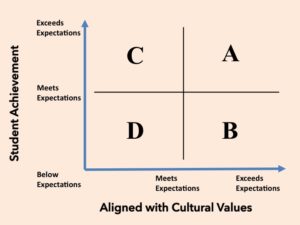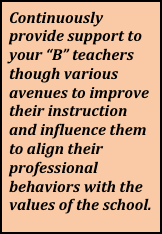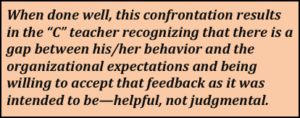Transformational Teachers: The school with the most “A” teachers wins
The first article in this series focused on the Transformational Principal and the 4D’s of school turnaround leadership—Discernment, Details, Decisions and Diligence. In that article I made the widely understood point that the extent to which student achievement improves is contingent upon the quality of instruction in the school. Furthermore, I outlined the two major influences on the quality of instruction in a school—quality people and quality processes (or the “P & P”). In this article, I will address the most influential variable in any school—the teacher. Specifically, I will focus on the type of teachers that are necessary to assist a school in turnaround status and some ideas as to how to lead them.
Identifying Transformational Teachers
Over the years I have had the privilege of working with and observing some of the finest teachers our profession has to offer. While I respect and value the talents and effort of all teachers, I find no better professional satisfaction than to see a highly skilled teacher in a turnaround school. It provides me with the hope and confidence that someday we will meet our national commitment to teach all students regardless of socio-economic status, skin tone, or exceptionality.
However, the reality is that turnaround schools are often staffed by an overabundance of newer teachers who have yet to develop the skills that are necessary to impact the achievement of our most needy students. This is problematic, as the timeline for school turnaround often does not allow adequate time for teachers to develop. Furthermore, not even all experienced teachers are a “fit” for turnaround work. Therefore, it is extremely important to understand the type of teacher that is needed to help transform a school.
In Leadership Engine (1997), Noel Tichy describes a model designed and used by Jack Welsh, former CEO of General Electric when identifying different types of people in an organization. With modifications to his Performance-Values Matrix for the field of education, I have found it helpful when assisting administrators in selecting, developing and managing the teachers in their schools.
The model consists of four quadrants along two axes. In education, the y-axis represents various levels of student achievement; the x-axis represents the degree to which the teacher aligns his/her behavior with the desired, explicit culture of the turnaround school. (I will address transitional school culture in a future article.)

The Turnaround School with the Most “A” Teachers Wins
Needless to say, a turnaround school that attracts, retains and develops a faculty of all “A” teachers significantly increases its chances of success. These are the types of teachers needed in transformational schools. “A” teachers have a proven track record of student success and exhibit the professional behaviors that align with the expectations of the turnaround school. In successful turnaround schools, they serve as teacher leaders, and they model and coach others in the behaviors necessary for schools to achieve true transformation. With proper teacher leader training, “A” teachers serve as a conduit for assisting other teachers in not only improving their instruction but also in aligning their behaviors with the organizational norms.
“A” Teachers need Quality Feedback
The “A” teachers often display the desire and the effort to add to their skill set in their ability to teach as well as their professional behaviors, and they actively seek out the feedback necessary to become highly effective in both areas. When presented with quality feedback they are highly motivated to improve and are not prone to rely only upon their current skill set. However, “A” teachers tend to receive lots of praise—and it is well deserved—but not enough of the feedback that is necessary for rapid growth. When “A” teachers receive high quality feedback they are energized and improve their skills significantly.
To effectively lead an “A” teacher, school aministrators must become highly skilled in delivering high quality feedback, which is one of the most powerful skills of a transitional leader. (More on quality feedback will be addressed in a future article.)
Grow Your “B” Teachers
While it would be optimal to have a school of all “A” teachers, it is well known that new and inexperienced teachers overwhelmingly staff most turnaround schools.
 The next category of teacher falls in the “B” quadrant. While “B” teachers do not yet have the skills to influence student achievement in a significant way, they have tremendous heart and drive. They want to align their behaviors with the expectation of the organization and are highly ‘coachable.” It is incumbent on school leaders to have strong, systemic processes for developing teachers that include many avenues for high quality, frequent feedback so that the rate of improvement is high. School leaders—including “A” teachers—should devote significant amounts of time to developing their “B” teachers by providing support in improving instruction and professional behaviors as well as providing the emotional support necessary to remain diligent in the learning process. With deliberate practice, quality feedback, mentorship, and time, “B” teachers can develop into “A” teachers.
The next category of teacher falls in the “B” quadrant. While “B” teachers do not yet have the skills to influence student achievement in a significant way, they have tremendous heart and drive. They want to align their behaviors with the expectation of the organization and are highly ‘coachable.” It is incumbent on school leaders to have strong, systemic processes for developing teachers that include many avenues for high quality, frequent feedback so that the rate of improvement is high. School leaders—including “A” teachers—should devote significant amounts of time to developing their “B” teachers by providing support in improving instruction and professional behaviors as well as providing the emotional support necessary to remain diligent in the learning process. With deliberate practice, quality feedback, mentorship, and time, “B” teachers can develop into “A” teachers.
No Room for “D” Teachers
While it may seem out of order, the next group of teachers falls in the “D” category. “D” teachers have little impact on student achievement and their behaviors do not align with the desired organizational culture. Unfortunately, turnaround schools, like most organizations, often have some “D” teachers. Clearly the optimal situation is to remove a “D” from a turnaround school and transformational principals have developed the skills to do so. Principals who want to be transformational leaders simply must learn this skill. To do so requires the ability to provide clear and documented feedback and the ability to confront the teacher with their behaviors as compared to the expectations of the turnaround school. When the transformational principal is successful, “D” teachers either leave of their own accord through transfer or resignation or are released.
Unfortunately, this process often takes what a turnaround school lacks—time. Time that would be better spent fine-tuning the processes necessary to improve instruction and increase achievement. If a school administrator does not have the skills or the time to remove a “D” teacher, they often try to minimize the damage by moving them to areas where they will have limited impact on the overall achievement of the school. Lastly, it is important to understand that the presence of a few “D” teachers does not mean that a school cannot be transformed. Remove or minimize the damage of “D” teachers
“C” Teachers. Your Enemy or…
The final category of teacher is the most challenging type to lead. “C” teachers get significant student achievement results but do not share the values of the school turnaround culture. “C” teachers tend to be great in the classroom but not outside the classroom. They often have students who like them and parents who request them. They have documented results to support their effectiveness. However, from an organization standpoint, “C” teachers are the enemy of a turnaround school culture. They tend to have little or no tolerance for the organizational needs or processes. When asked, they mostly want to be left alone to teach “their” students. Unlike “A” teachers whose language is highly inclusive (e.g., “us”, “we”, “our”, “team”), “C” teachers’ language is highly individualistic (e.g., “I”, “me”, “my”, “mine”).
This is particularly concerning as the extent to which a school will successfully turnaround is contingent upon the degree to which the adults can collaborate with one another. Because “C” teachers do not work well with others—or are highly selective about whom they work with—they serve as poor role models for other teachers, particularly the “B” teachers who are often at a stage of their careers where they are highly influenced by the behaviors of others in their work environments.

Interestingly, the goal with a teacher who falls in the “C” category is to retain them in your school. Yes, retain your enemy. However, it does not mean keep them as a “C” teacher. Your goal is to influence them to align their behaviors with the needs of the organizational culture. In other words, influence them to become an “A” teacher. If they choose to align their behavior, in many cases they can become your strongest “A” teachers. If they don’t align their behavior, you must be willing to let them go. Both are viable options. The only option that is not acceptable is to allow a “C” teacher to remain a “C” teacher thereby undermining the processes necessary to transform a school. Unfortunately, many leaders are willing to sellout their organization for the results that a “C” teacher contributes to the school.
The Skill of Confrontation
To influence a “C” teacher requires a strong leader who is firmly grounded in the processes that must be in place to transform a school. Furthermore, they must possess or be willing to develop the critical skill of confrontation. When done well, this confrontation results in the “C” teacher recognizing that there is a gap between his/her behavior and the organizational expectations and being willing to accept that feedback as it was intended to be—helpful, not judgmental.
Confrontation must not be viewed as something negative but as a necessary leadership skill to transform a school. Not all school leaders are comfortable with or posses the skills of confrontation. Indeed, once a leader develops this skill, the probability of transforming a school increases significantly. It takes time, practice and feedback to learn this skill and all leaders are capable of learning it. Retain your “C” teachers by influencing them to become “A” teachers. If they won’t, let them go.

P&P. The right People with the right Processes
For a school to be successfully transformed, it requires the “right” people with the “right” processes—the “P & P.” The team with the most “A’s” wins.
Mark Rolewski has assisted schools and school districts in designing and implementing successful turnaround initiatives for over 19 years. Mark has assisted with school turnaround in many districts and schools including those in New York City, Hartford, New Orleans, Memphis, Kansas City and Los Angeles. He is widely sought after by schools and school districts to speak about and assist with turnaround initiatives. This is the second installment of an ongoing series that outlines many of the components of a turnaround initiative.
For additional information, please visit Mark’s webpage.
Click here if you would like to sign up to receive future articles via email.
Well stated!
When I started teaching, so much of my training consisted of trial and error. We were not assigned mentors nor did we receive constructive feedback. At the end of the year we earned a Satisfactory or Unsatisfactory rating. Teachers need to embrace rating processes, and not be so threatened by them, if they want to grow professionally and be part of a successful staff.
Thank you, Kathy. I appreciate that you took the time to read and respond to this article. You make many valid points. At this point in time, it baffles me why learning to teach continues to be primarily a trial and error process that relies heavily on informal or fractured processes. I see too many first and second year teachers struggling to survive particularly in schools where there are so many children living in poverty and feel like the pre-service and in-service processes have failed them. I also work with an overwhelming number of growth-minded experienced teacher leaders—like you—who are eager for opportunities to strengthen their skills and welcome feedback. When teachers embrace a valid and reliable evaluation system and administrators understand what quality looks like and possess the ability to provide feedback that is valued by teachers and focused on development, great things happen. Again, your thoughts are appreciated.
Mark,
I love this article, I worked as an Instructional Aid while my children were attending the same school. I could see the many teacher differences you put into perfect perspectives. I also concur how the A teachers impact the success of students through the early years while inspiring the C teachers to get involved while bringing creative excitement to the classroom as well as outside activities that provide a more personal and fun involvement versus the academic day. The kids embrace the teacher more when they are back in the classroom setting, this also gives an advantage to the teacher who get to know their students personalities better. Parent involvement is also key as their children love to see the interaction between parent and teacher. Many times I found more dialogue with my children after their day at school, they pick up on my heartfelt interest in their daily happenings when they come home from a sometime tough day at school sponging the curriculum. It gives all of us more of a family relationship between home, teacher, and school activities thus bringing the social networking with parents and everyone’s involvement. Thank you Mark for all you have done, and all you continue to do for the love of children, and the importance of education and it’s many challenges you tackle! I personally know you, I must say you are a wonderful husband, father, and friend, dedicated to your family. You were raised with a great foundation and found a way to share your talents. Wishing continued success, always.
Linda,
Thank you for your kind and heartfelt comments. I appreciate you taking the time to read and respond to this post. Know that your wonderful children are a result of the family values that you have instilled in them along with your support for their education. Education is the responsibility of all of us.